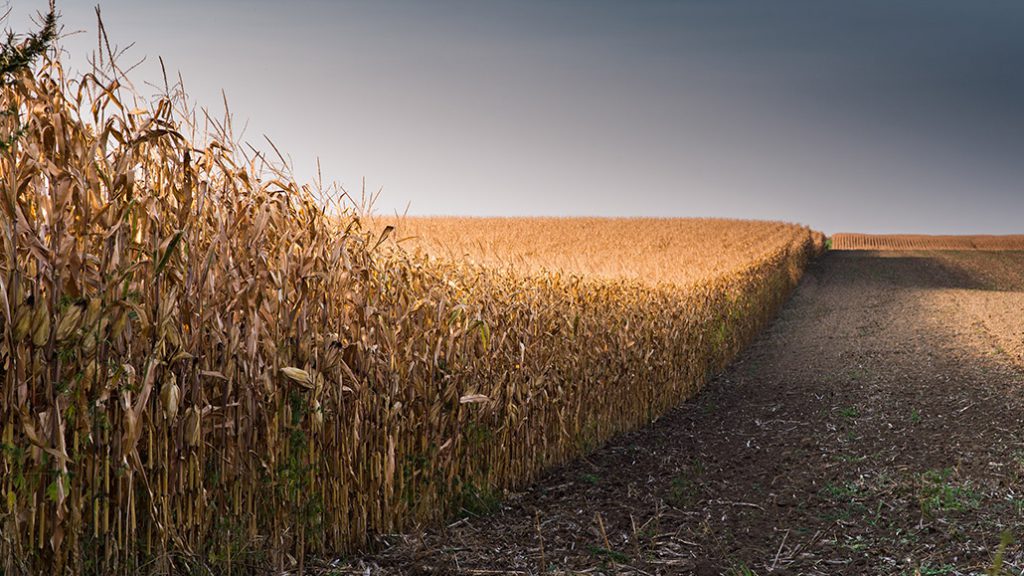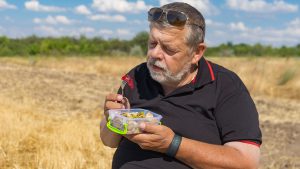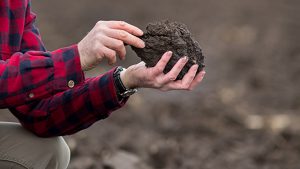Corn harvest
STRATEGIES TO MAINTAIN QUALITY

WEATHER DICTATES THE harvest season. But while hard to predict, it’s not all-powerful.
When it comes to maintaining corn quality, prioritizing fields, monitoring potential fungus issues, and calibrating equipment can all help prepare for changing and challenging conditions.
SCOUT — AND PRIORITIZE
It’s not possible to prepare for harvest challenges if crop conditions are not known, says Ben Rosser, corn specialist with the Ontario Ministry of Agriculture, Food and Rural Affairs. Consequently, scouting for potential or existing problems is critical, as is continual monitoring where issues — whether existing or potential — are identified.
As anyone who grew corn in 2018 likely recalls, one of those problems is ear mould.
“Check to see which fields have lodging or quality issues. Know which fields are at potentially higher risk if harvest is delayed,” says Rosser, reiterating weather monitoring becomes even more critical when mould issues are present.
What hybrid was planted is another consideration during pre-harvest planning, as well as in crop selection for the following growing season. Particularly if conditions are conducive to ear mould development, Rosser says it might be worth harvesting more susceptible varieties first.
Harvesting corn with higher-than-ideal moisture levels, while more expensive to dry, can also save crop quality given damp conditions.
“It really depends on the year, but from a quality deterioration perspective those are the things that jump out.” Rosser says.
FUNGICIDE AN OPTION
A substantial portion of Ontario’s corn crop is either on or ahead of schedule this year, according to Russ Barker, a Pioneer Hybrid sales representative and certified crop adviser based near St. Marys. Taking additional precautions to safeguard crop quality can pay off because it is very difficult to determine what diseases will be present late in the season.
“Assuming weeds and fertility are under control, the only other management choice is fungicide. While we know not every year it pays, there are more years than not when it does,” says Barker.
“When fungicide does pay, it pays significantly.”
Barker adds he and his farm colleagues “do not hesitate” to apply fungicide on their own corn. In his experience with both silage and grain corn, supporting overall plant health in this way improves standability.
“Fungicide on wheat? No question, that’s a slam dunk. It’s almost slam dunk on corn,” says Barker. “The downside is it adds a little moisture.”
CALIBRATING ELECTRONICS
Ensuring equipment is ready to operate is another important — and more obvious — factor in harvest readiness. A lesser considered part of that, says Rosser, is calibrating electronics.
“From a data collection perspective, there’s work showing grain moisture can impact the accuracy of yield monitors, so change and calibrate as you go to match conditions.”
Greg Kitching, crop advisor and technology consultant with Premier Equipment, also emphasizes the importance of calibration – but advances in yield mapping and other data tools now allow many systems to calibrate automatically.
“Current systems can be quite accurate. We’ve gone from plus or minus five per cent accurate to plus or minus one per cent,” says Kitching.
Such accuracy does not eliminate operator error, though. Ensuring the right labels are applied to the right variables can be a challenge, and one impacting the quality of information garnered post-harvest.
“The simplest problem, and the biggest, is having your fields properly named. We spend more time fixing spelling mistakes than essentially anything else. The capital ‘Smith’ farm and the lower-case ‘smith’ farm are two separate properties,” Kitching says.
“Sometimes it’s operators choosing the wrong field name. The software can mostly sort it out spatially now, but it’s still a headache.”
Field names aside, growers employing data-driven technologies should ensure variables such as hybrid variety and variable rate inputs (e.g. fertilizer) are properly segmented and accounted for. With accurate planting records, data processing is much easier. Doing so allows for easier processing post-harvest.
“It gives you opportunity to analyze what happened quickly,” says Kitching. He also reiterates seed purchases for the following year’s crop tend to happen soon after harvest ends, making the efficient and accurate analysis of data even more important. •











